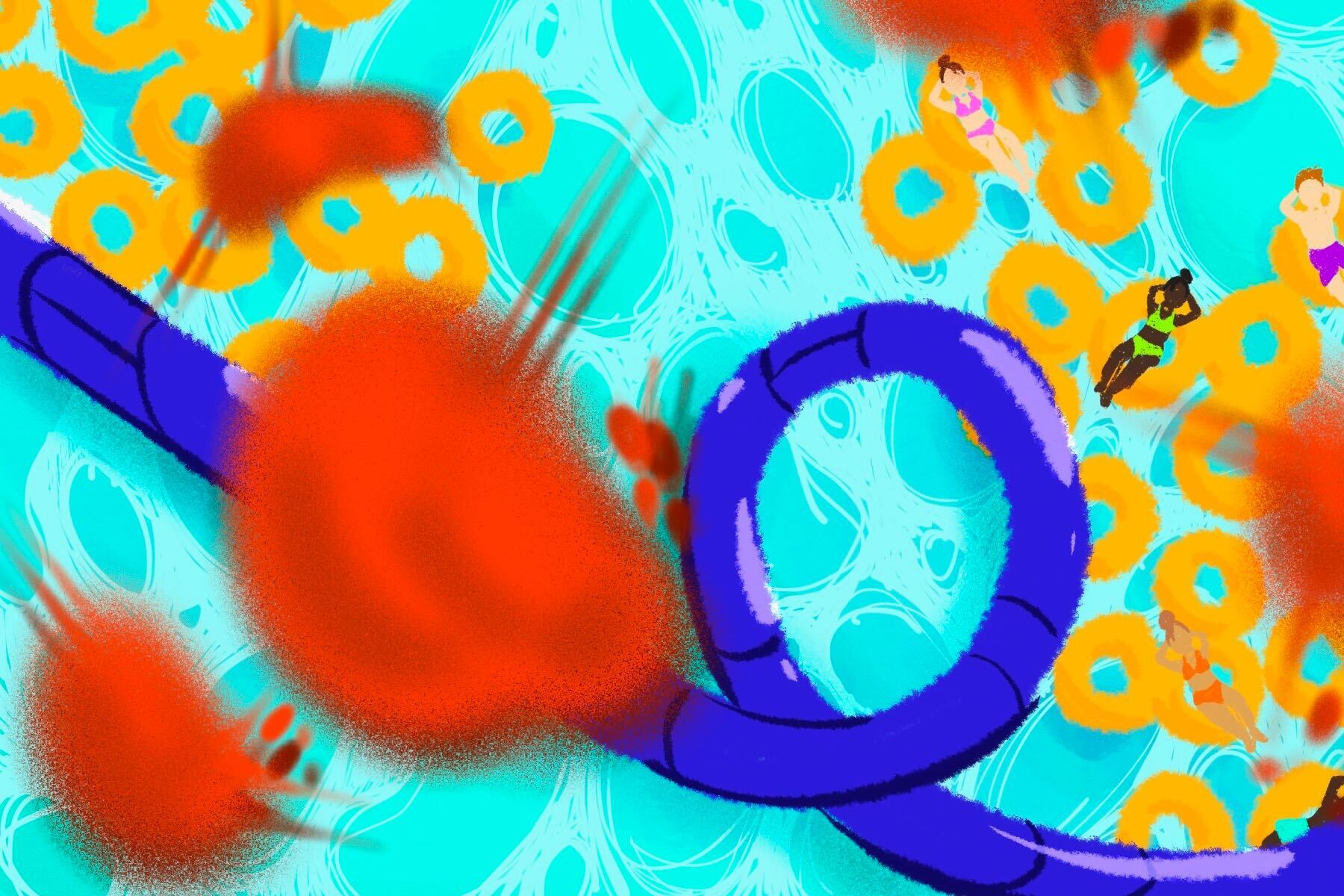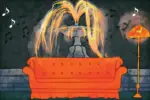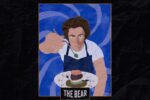Your summer isn’t officially over until you’ve watched “Class Action Park.” Recently released on HBO Max, the documentary provides one final summertime thrill in the form of an enthralling but cautionary tale about what happens when a theme park’s only rule is that there are no rules.
“Class Action Park” tells the story of Action Park, a New Jersey waterpark open from 1978-1996 and founded by Gene Mulvihill, a shady Wall Street businessman. Mulvihill had a disdain for rules and “didn’t believe in insurance,” making Action Park the tristate area’s epicenter of chaos and danger. The water park was run by teenagers, contained rides that weren’t designed by engineers and averaged hundreds of injuries a day.
In keeping with the unprecedented nature of 2020, “Class Action Park” is a documentary like no other because Action Park is unlike any amusement park that has ever existed. Even the most seasoned Disney or Six Flags attendee will be equal parts fascinated and shocked by stories of the park’s unapologetic lawlessness. Throughout the documentary, former Action Park employees and guests discuss their memories of the park with a mix of nostalgia and horror, detailing how visits to the park felt like spending a day in a wild ‘80s movie.
For someone like me, a college student whose understanding of the ‘80s amounts to Whitney Houston and “Full House,” watching “Class Action Park” was a fun escape to the latchkey kid days of that decade. It was a time when parents didn’t know or care what their kids were up to as long as they were home for dinner, which is a far cry from the world of packed schedules and helicopter parenting that I grew up with. Action Park was a product of its time in that it bottled up this carefree energy and unleashed it in the form of drunk teenage employees operating water slides with no safety regulations.
While the documentary emphasizes that Action Park reflected ‘80s attitudes, it does not celebrate this phenomenon. Action Park’s uninhibited fun came at the cost of people’s lives. Multiple people died on the attractions. Frustratingly, most were deaths that could have easily been prevented if the park had proper safety measures in place.
“Class Action Park” is exciting to watch for people my age because the lack of regulation is so unimaginable. However, it is also a powerful reminder that rules are there for a reason. The documentary proves that there is such a thing as too much fun and made me appreciate growing up in a world full of strict rules.
1. Gene Mulvihill Only Cared About Money and Fun
While he passed away before the documentary was made, the park’s founder is very much the star of the show in “Class Action Park,” for better or for worse. The former employees and guests describe Mulvihill as a larger-than-life character who hated rules with a burning passion and would do anything to make a dollar or two.
Mulvihill originally had a career on Wall Street but, when his company was suspended by the Securities and Exchange Commission for fraud, he shifted his attention to the theme park industry. He wanted to create an amusement park where guests had complete control of the action, and so Action Park was born.
From the get-go, Mulvihill’s love of lawlessness set the park up for uncontrollable danger. He established a fake insurance company so that anyone who sued Action Park would get little to no money out of the lawsuit. Mulvihill also hired aspiring ride designers with a whole lot of crazy ideas and no engineering experience to build Action Park’s rides. He would often take the original designs and make them even more extreme to better fit his liking. Additionally, rather than testing rides using proper safety guidelines, Mulvihill would throw $100 bills at teenage employees to try them out and then figure out what needed to be fixed based on their injuries.
Even when he did attempt to care about safety, his methods were questionable to say the least. For example, the park had an issue with guests riding ski lifts and dropping heavy ride carts onto people below just for fun. To get people to stop, Mulvihill staged a scene where he pretended to kill an employee who was acting as an unruly ski lift guest in order to teach the other guests a lesson.
Yeah. This is the kind of guy we’re dealing with.
It’s safe to say that the safety of the guests was the last thing on Mulvihill’s mind. While his antics are bizarre and amusing to learn about now, they were also deadly. Six people are said to have died at Action Park. However, the documentary suggests that the number of deaths might be even higher given how skilled Mulvihill was at fraud and hiding facts.
Mulvihill is someone who should never have been allowed to drive a car, let alone helm the creation of a theme park. Hearing about this guy made me feel incredibly relieved that I was not around to have even had a chance of attending the theme park of his dreams.
2. The Rides Were Astoundingly Dangerous
Let me be very clear: I love theme park rides. However, there is not enough money in the world to have persuaded me to step foot near an Action Park attraction.
No quote better summarizes Action Park’s rides than this one from former Park Operations Manager Ed Youmans: “Let me put it this way: There’s two places that you can experience 9Gs as a civilian. One is the backseat of an F-14 and the other one is at Action Park.” He is referring to the infamous Cannonball Loop, which sent riders’ bodies plummeting down a steep, pitch-dark tube and through a crazy loop. The ride would often knock people’s teeth out and leave them so dizzy that they couldn’t stand up at the end.
Other Action Park rides included the Tarzan Swing, which would drop people into numbingly cold stream water at awkward angles, and the Alpine Slide, which had pictures of bloody previous riders posted at the start as a warning of what was to come. There was also a go-kart ride that allowed guests to drive off the track and take the karts for a spin on the nearby highway or chase employees.
My personal favorite to learn about was the Colorado River Ride, which was basically an extreme lazy river. It went so ridiculously fast that tubes would travel right over the side walls. Tubes would also constantly get stuck, causing people to get so frustrated that they would often jump out of their tubes and get into fist fights with other riders. There was, of course, no lifeguard in sight to help settle disputes or remedy tube malfunctions.
In addition to describing the insane rides, the documentary highlights how typically, the illusion of danger is what makes amusement park rides fun. Statistically speaking, you are safer on a rollercoaster than riding in a car. Action Park turned this notion on its head by prioritizing “fun” at all costs, making me very grateful for the endless safety measures that theme parks must abide by today.
3. The Culture of the Park Encouraged Chaos
It wasn’t as if guests left the park shaking their heads at the extraordinary danger — people went to Action Park with the goal of getting injured. Most attendees were teenagers who longed for some Alpine Slide or Tarzan Swing battle scars. Given that the park’s employees were all teenagers who cared more about partying than ensuring the safety of the guests, this goal was often accomplished. A former guest compares the park to “The Purge,” as it was a place where people could do whatever they wanted whenever they wanted and face absolutely no consequences.
Alcohol played a huge role in the chaotic culture of Action Park. It was readily available at multiple locations, and Mulvihill hosted many festivals that featured alcohol in a starring role. He even once had an entire brewery sent from Germany just for one of these festivals.
Additionally, people would display stereotypically rowdy New Jersey behavior. The culture of 1980s New Jersey infiltrated Action Park in the form of yelling profanities at bloody guests as they exited attractions and the aforementioned fist fighting.
As a New Jersey native myself, I am all for a little bit of rough-and-tumble Jersey fun. However, normalizing that energy in the culture of a waterpark sounds like a terrible idea to me.
4. Deadly Consequences
The documentary does a great job of balancing the hilarious descriptions of the attractions with the seriousness of the park’s deadly history. The last half hour of “Class Action Park” focuses on the story of George Larsson Jr., Action Park’s first victim. Larsson died at just 19 years old after being thrown from the Alpine Slide and hitting his head on rocks.
Larsson’s parents and brother discuss the unspeakable loss with such a deep sadness and justified anger at Mulvihill. Had he simply followed basic safety guidelines, their son and brother would be alive. Even more devastating is the fact that Mulvihill never once called the family to apologize. He also lied about what happened, telling newspapers that Larsson was an employee riding the slide on a rainy night — none of which was true. To top it all off, Mulvihill made the family’s lawsuit a living nightmare and they ended up settling for a fraction of the money they deserved.
Other known deaths at the park include wave pool drownings and an incident where someone was electrocuted on a ride. Multiple speakers in the documentary, including Larsson’s mother, point out that one death at a theme park is too many.
Unfortunately, Action Park was the brainchild of a man who eschewed rules and only cared about his wallet. This meant that he devoted his energy to using his political and economic power in the area to ensure that the park continued to operate with no adjustments after people died. He maximized his clout to limit bad press coverage and responses from town leaders that would force him to make the park safer, rather than just preventing the deaths from happening in the first place.
Thankfully, Action Park was the first and last of its kind. The world has changed too much for there to ever be another theme park without rules, even if another Gene Mulvihill is out there. While I enjoyed the hour and a half foray into the pandemonium of Action Park, I am forever thankful that I was not there to see it for myself.

















